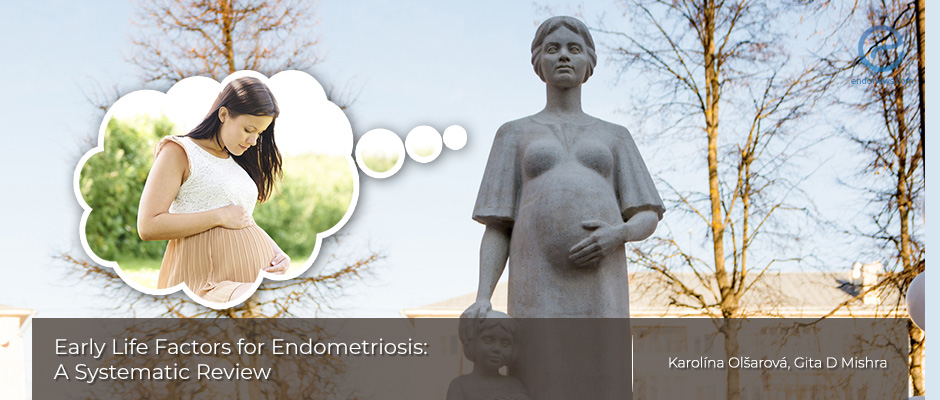Early Life Factors for Endometriosis
Apr 8, 2020
A systematic review of the epidemiological evidence on early life factors for endometriosis
Key Points
Highlight:
- Dr. Mishra's group provides a systematic review of the epidemiologic evidence on early life factors associated with the subsequent diagnosis of endometriosis.
Background:
- Many aspects of endometriosis and its etiology remain unclear, including risk factors and the underlying biological mechanisms.
- Exposures during early life, including in utero, are thought to play an important role in the subsequent onset of the condition.
- Several individual studies have also investigated early life factors linked to childhood development and subsequently diagnosed endometriosis.
- Unfortunately, much of the findings from studies on early life exposures and diagnosed endometriosis appears mixed and difficult to assess.
Key points:
- Based on their assessment score, a total of 11 studies were selected for inclusion.
- Five case-control studies, two cross-sectional studies, and four cohort studies.
- The women born with low birth weight (less than 2.5 kg or 5.5 lb) were more likely to have an increased likelihood of endometriosis diagnosis.
- The limited evidence requiring additional risk factors:
- Only one study showed the association of endometriosis diagnosis with in utero exposure to diethylstilbestrol, a synthetic estrogen.
- Evidence on exposure to maternal smoking during pregnancy was mixed.
- Limited evidence is available on infant feeding.
- Evidence in relation to preterm birth was lacking in this review.
Conclusions:
- This review finds that evidence available on early life exposures suggests that low birth weight is a risk factor for endometriosis diagnosis.
- Further studies are highly required; Increase the sample size of the case-control studies, and well-designed study with consistent measurement methods.
Lay Summary
Endometriosis affects approximately 10% of reproductive-aged women. Despite the significant impact, the etiology of endometriosis is still unclear.
A recent systematic review of 15 studies of adolescents found that overall 65% of girls undergoing laparoscopic investigation were diagnosed with endometriosis. The high prevalence of endometriosis among young women suggests the onset of the disease might be earlier than anticipated. Research that focuses on potential factors in early life, including exposures in utero, may provide insights on the etiology of endometriosis.
Several individual studies have also investigated early life factors linked to childhood development and subsequently diagnosed endometriosis. These factors include preterm birth, low or high birth weight, type of primarily feeding of infants and bodyweight during childhood, as well as in utero exposures to smoking and diethylstilbestrol, a synthetic form of estrogen. However, these findings are highly mixed, so a systemic review is required.
Here, Dr. Mishra's group from Australia provides a systematic review of the epidemiologic evidence on early life factors associated with the subsequent diagnosis of endometriosis. This paper was recently published in the journal “Human Reproduction Update”.
Based on the criteria, a total 11 studies were selected for this systemic analysis, five papers being case-control study. Two of them are cross-sectional and four have cohort studies. The review included articles published in English until 10 June 2018 with original data from studies with diagnosed endometriosis.
Six studies investigated the relationship between birth weight and subsequent endometriosis diagnosis. Among them, three studies provide evidence showing low birthweight tends to have an increased rate of a subsequent endometriosis diagnosis later in life. Specifically, low birth weight (less than 2.5kg) was associated with a 3-fold increased likelihood of endometriosis diagnosis. Interestingly, there is no evidence of an association for high birthweight with endometriosis diagnosis.
Though some studies mentioned a modest association between in utero exposure to maternal smoking and endometriosis diagnosis, this association was not confirmed in other studies. The association of exposure to the diethylstilbestrol, a synthetic estrogen, with endometriosis diagnosis showed a promising correlation but still requires further study. Evidence in relation to preterm birth was lacking in this review due to the inconsistent results. Also, the association of exposure to maternal smoking during pregnancy was highly mixed. Therefore, more detailed studies are required for further analysis. Limited evidence is available on infant feeding, chemical exposure, and preterm birth in this study.
In conclusion, Dr. Mishra group suggests in this review that the low birth weight is a risk factor for endometriosis diagnosis. However, further studies are highly required by increasing the sample size of the case-control studies, and well-designed studies with consistent measurement methods.
Research Source: https://pubmed.ncbi.nlm.nih.gov/32141508/?from_single_result=32141508&expanded_search_query=32141508
Early life Endometriosis In utero Protective factors Risk factors Systematic review LBW DES dietilstilbestrol

